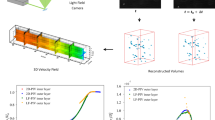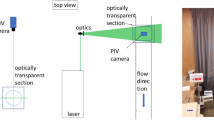Abstract
The flow in a streamwise/wall-normal plane of a turbulent boundary layer at moderate Reynolds number (Re θ = 2,200) is characterized using two stereo PIV systems just overlapping in the streamwise direction. The aim is to generate SPIV data for near-wall turbulence with enough spatial dynamic range to resolve most of the coherent structures present in the flow and to facilitate future comparisons with direct numerical simulations. This is made possibly through the use of four cameras with large CCD arrays (4,008 px × 2,672 px) and through a rigorous experimental procedure designed to minimize the impact of measurement noise on the resolution of the small scales. For the first time, both a large field of view [S x ; S y ] = [2.6δ; 0.75δ] and a high spatial resolution (with an interrogation window size of 13.6+) have been achieved. The quality of the data is assessed through an analysis of some of the statistical results such as the mean velocity profile, the rms and the PDF of the fluctuations, and the power spectra.











Similar content being viewed by others
References
Adrian RJ (1991) Particle imaging techniques for experimental fluid mechanics. Annu Rev Fluid Mech 23:261–304
Adrian RJ (1997) Dynamic ranges of velocity and spatial resolution of particle image velocimetry. Meas Sci Technol 8:1393–1398
Adrian RJ (2007) Hairpin vortex organization in wall turbulence. Phys Fluid 19
Adrian RJ, Meinhart C, Tomkins C (2000) Vortex organization in the outer region of the turbulent boundary layer. J Fluid Mech 422:1–54
Baur T, Koengeter J (2000) High-speed PIV and the post-processing of time-series results. Euromech 411
Carlier J, Stanislas M (2005) Experimental study of eddy structures in a turbulent boundary layer using particle image velocimetry. J Fluid Mech 535:143–188
Chong MS, Soria J, Perry AE, Chacin J, Cantwell BJ, Na Y (1998) Turbulence structures of wall bounded shear flows found using DNS data. J Fluid Mech 357:225–247
Christensen KT (2004) The influence of peak-locking errors on turbulence statistics computed from PIV ensemble. Exp Fluids 36:484–497
Coudert S, Schon JP (2001) Back-projection algorithm with misalignement corrections for 2D3C stereoscopic PIV. Meas Sci Technol 12:1371–1381
DelAlamo JC, Jimenez J, Zandonade P, Moser RD (2006) Self-similar vortex clusters in the turbulent logarithmic region. J Fluid Mech 561:329–358
van Doorne CWH, Westerweel J, Nieuwstadt FTM (2003) Measurement uncertainty of stereoscopic-PIV for flow with large out-of-plane motion. EUROPIV2 workshop, Zaragoza, Spain
Elsinga GE, Scarano F, Winieke B, van Oudheusden BW (2006) Tomographic particle image velocimetry. Exp Fluids 41:933–947
Foucaut JM, Milliat B, Perenne N, Stanislas M (2003) Characterisation of different PIV algorithm using the europiv synthetic image generator and real images from a turbulent boundary layer. EUROPIV2 workshop, Zaragoza, Spain
Foucaut JM, Carlier J, Stanislas M (2004) PIV optimization for the study of turbulent flow using spectral analysis. Meas Sci Technol 15:1046–1058
Ganapathisubramani B, Longmire E, Marusic I (2006) Experimental investigation of vortex properties in a turbulent boundary layer. Phys Fluids 18:05510,501–05510,514
Guala M, Hommema S, Adrian R (2006) Large scale and very large scale motions in turbulent pipe flow. J Fluid Mech 554:521–542
Guichard L, Lecordier B, Reveillon J (1998) Evaluation des algorithmes utilises en piv grace a la simulation numerique directe. 6eme Congres Francophone de Velocimetrie Laser
Hambleton WT, Hutchins N, Marusic I (2006) Simultaneous orthogonal-plane particle image velocimetry measurements in a turbulent boundary layer. J Fluid Mech 560:53–64
Herpin S, Wong CY, Laval JP, Stanislas M, Soria J (2007) Comparison of high spatial resolution stereo-PIV measurements in a turbulent boundary layer with available DNS dataset. In: 16th Australasian Fluid Mechanics Conference, Gold Coast, Australia
Hutchins N, Marusic I (2007) Evidence of very long meandering features in the logarithmic region of turbulent boundary layers. J Fluid Mech 579:1–28
Hutchins N, Hambleton WT, Marusic I (2005) Inclined cross-stream stereo particle image velocimetry measurements in turbulent boundary layers. J Fluid Mech 541:21–54
Jie L (2006) Etude detaillée des structures coherentes de la zone tampon de la turbulence de paroi a l’aide de données de PIV stereoscopique. PhD thesis, Ecole Centrale de Lille et Université de Lille
Keane RD, Adrian RJ (1990) Optimization of particle image velocimeters. Part 1: Double pulsed systems. Meas Sci Technol 1:1202–1215
Keane RD, Adrian RJ, Zhang Y (1995) Super-resolution particle image velocimetry. Meas Sci Technol 6:754–768
Kim J, Moin P, Moser R (1987a) Turbulence statistics in fully developed channel flow at low reynolds number. J Fluid Mech 177:133–166
Kim J, Moin P, Moser R (1987b) Turbulence statistics in fully developed channel flow at low reynolds number. J Fluid Mech 177:133–166
Kostas J (2002) An experimental investigation of the structure of a turbulent backward facing step flow. Ph.D. thesis, Monash University
Kostas J, Foucaut J, Stanislas M (2005) Application of double spiv on the near wall turbulence structure of an adverse pressure gradient turbulent boundary layer. In: 6th International Symposium on PIV, Pasadena, CA
Lecordier B, Westerweel J (2003) The EUROPIV synthetic image generator (S.I.G.). EUROPIV2 workshop, Zaragoza, Spain
Moin P, Mahesh K (1998) Direct numerical simulation : a tool in turbulence research. Annu Rev Fluid Mech 30:539–578
Parker K, von Ellenrieder K, Soria J (2005) Using stereo multigrid (SMDPIV) measurements to investigate the vortical skeleton behind a finite-span flapping wing. Exp Fluids 39:281–298
Perry AE, Henbest S, Chong MS (1986) A theoretical and experimental study of wall turbulence. J Fluid Mech 165:163–199
Prasad A, Jensen K (1995) Scheimpflug stereocamera for particle image velocimetry in liquid flow. Appl Opt 34(30):7092–7099
Prasad AK (2000) Stereoscopic particle image velocimetry. Exp Fluids 29:103–116
Pu Y, Meng H (2000) An advanced off-axis holographic particle image velocimetry (HPIV) system. Exp Fluids 29:184–197
Raffel M, Willert C, Kompenhans J (1998) Particle image velocimetry: a practical guide. Springer, Berlin
Robinson SK (1991) Coherent motions in the turbulent boundary layer. Annu Rev Fluid Mech 23:601–639
Scarano F, Poelma C, Westerweel J (2007) Towards four dimensional particle image velocimetry. In: 7th International symposium on particle image velocimetry
Soloff S, Adrian R, Liu ZC (1997) Distortion compensation for generalized stereoscopic particle image velocimetry. Meas Sci Technol 8:1441–1454
Soria J (1996) An investigation of the near wake of a circular cylinder using a video-based digital cross-correlation particle image velocimetry technique. Exp Thermal Fluid Sci 12:221–233
Soria J (2006) Lectures notes on turbulence and coherent structures in fluid, plasma and non-linear media, Chap. 7. World Scientific, Singapore
Soria J, Atkinson C (2008) Towards 3c-3d: volume fluid velocity field measurement—tomographic digital holographic PIV (tomo-HPIV). Meas Sci Technol 19. doi:10.1088/0957-0233/19/7/074002. http://stacks.iop.org/MST/19/074002
Spalart PR (1988) Direct simulation of a turbulent boundary layer up to R θ = 1410. J Fluid Mech 187:61–88
Stanislas M (2005) Main results of the second international piv challenge. Exp Fluids 39:170–191
Stanislas M, Perret L, Foucaut JM (2008) Vortical structures in the turbulent boundary layer: a possible route to a universal representation. J Fluid Mech 602:327–382
Tanashi M, Kang SJ, Miyamoto T, Shiokawa S, Miyauchi T (2004) Scaling law of fine scale eddies in turbulent channel flow up to R e τ = 800. Int J Heat Fluid Flow 25:331–340
Westerweel J (1996) Measurement of fully developed turbulent pipe flow with digital particle image velocimetry. Exp Fluids 20:165–177
Westerweel J (1997) Fundamentals of digital particle image velocimetry. Meas Sci Technol 8:1379–1392
Westerweel J, Adrian RJ, Eggels JGM, Nieuwstadt FTM (1993) Measurements with particle image velocimetry of fully developed turbulent pipe flow at low reynolds number. International Symposium on Application of Laser Technology to Fluid Mechanics
Willert C (1997) Stereoscopic digital particle image velocimetry for application in wind-tunnel flows. Meas Sci Technol 8:1465–1479
Willert CE, Gharib M (1991) Digital particle image velocimetry. Exp Fluids 10:181–193
Acknowledgments
The authors wish to thank Dr. Sebastien Coudert, research engineer at ‘Laboratoire de Mecanique de Lille’, and Dr. Jean-Marc Foucaut, senior lecturer at ‘Ecole Centrale de Lille’, for their technical support during the evaluation of the SPIV images and fruitfull discussions on the PIV technique. Daniel Mitchell, PHD student at the ‘Laboratory for Turbulence Research in Aerospace and Combustion’, is also gratefully acknowledged for having proofread this paper. Part of the computations presented in this paper were carried out using the Grid 5000 experimental testbed, an initiative from the French Ministry of Research through the ACI GRID incentive action, INRIA, CNRS and RENATER and other contributing partners (see https://www.grid5000.fr). The support of the Australian Research Council is also gratefully acknowledged.
Author information
Authors and Affiliations
Corresponding author
Appendix
Appendix
This appendix provides the detailed methodology employed to compute the effective cut-off wavenumber kc exp of the stereo PIV longitudinal power spectra. This wavenumber was defined as the wavenumber at which the signal-to-noise ratio of the experiment is equal to one.
Following Foucaut et al. (2004), the PIV power spectrum E PIV(k) can be expressed as
where:
-
E flow(k) is the exact spectrum of the flow.
-
E noise(k) is the PIV noise (including both recording and processing (at given IW size) sources of noise)
-
the squared cardinal sine function \(\left({\rm sin}_c(k{\frac{L_{\rm IW}}{2}})\right)^2\) is the PIV transfer function and represents the filtering over a square interrogation window.
At SNR = 1, by definition E flow(kc exp) = E noise(kc exp), and one gets
The spectrum of the flow is a priori unknown; however, in the present contribution, we propose to use as a reference the spectrum from a DNS of channel flow [see Herpin et al. (2007) for a presentation of the simulation; its characteristics are close to the ones of Kim et al. (1987b)'s]. As the PIV experiment and the DNS are at different Reynolds numbers (Re τ,DNS = 600 and δ+ PIV = 1,400), they are compared using the inner scaling from Perry et al. (1986):
where u τ is the friction velocity and y is the wall normal position at which the spectrum is computed. The non-dimensional PIV and DNS spectra read
The PIV and DNS non-dimensional spectra for the u component at y + = 100 are shown in Fig. 12, for a PIV IW size of 32 px × 32 px; 1,936 velocity fields were used to compute the PIV spectrum, and five time steps were used to compute the DNS spectrum (this corresponds to the spectrum presented in Sect. 4 in Fig. 11a). A very good agreement can be noted at low and intermediate wavenumbers, supporting the validity of the scaling employed. The disparity in the high wavenumbers domain denotes the influence of the PIV noise.
Now, assuming that the non-dimensional spectrum of the flow is equal to the non-dimensional spectrum of the DNS, the non-dimensional PIV spectrum at \(\tilde{k}c_{\rm exp}\) can be expressed as
The multiplication factor \(\left({\rm sin}_c\left(\tilde{k}c_{\rm exp}{\frac{L_{\rm IW}}{2}}{\frac{1} {y_{\rm PIV}}}\right)\right)^2\) represents the low-pass filtering effect of PIV due to the averaging over the interrogation window. Equation 7 indicates that \(\tilde{k}c_{\rm exp}\) can be retrieved as the wavenumber at which \(\tilde{E}_{\rm PIV}(\tilde{k})\) intersects with \(2\tilde{E}_{\rm DNS}(\tilde{k})\left({\rm sin}_c \left(\tilde{k}c_{\rm exp}{\frac{L_{\rm IW}}{2}}{\frac{1}{y_{\rm PIV}}}\right)\right)^2.\) This procedure is illustrated in Fig. 13. The non-dimensional cut-off wavenumber of the PIV spectrum is found to be \(\tilde{k}c_{\rm exp}=11.8\pm0.5,\) corresponding to a minimum resolvable spatial variation \(SV_{\rm min}^+={\frac{2\Pi y^+_{PIV}}{\tilde{k}c_{\rm exp}}}=53\pm2\) : a vortex of diameter d + = 53 will be resolved with a signal-to-noise ratio of 1 by the PIV measurements. Note that these values of \(\tilde{k}c_{\rm exp}\) and SV +min = d + were computed from the power spectra of the u component only (E 11). The same methodology can be applied on E 22 and E 33 as well, to derive a global cut-off wavenumber \(\tilde{k}c_{\rm exp}\) and a global minimum resolvable spatial variation SV +min (see Sect. 4).
Rights and permissions
About this article
Cite this article
Herpin, S., Wong, C.Y., Stanislas, M. et al. Stereoscopic PIV measurements of a turbulent boundary layer with a large spatial dynamic range. Exp Fluids 45, 745–763 (2008). https://doi.org/10.1007/s00348-008-0533-1
Received:
Revised:
Accepted:
Published:
Issue Date:
DOI: https://doi.org/10.1007/s00348-008-0533-1






